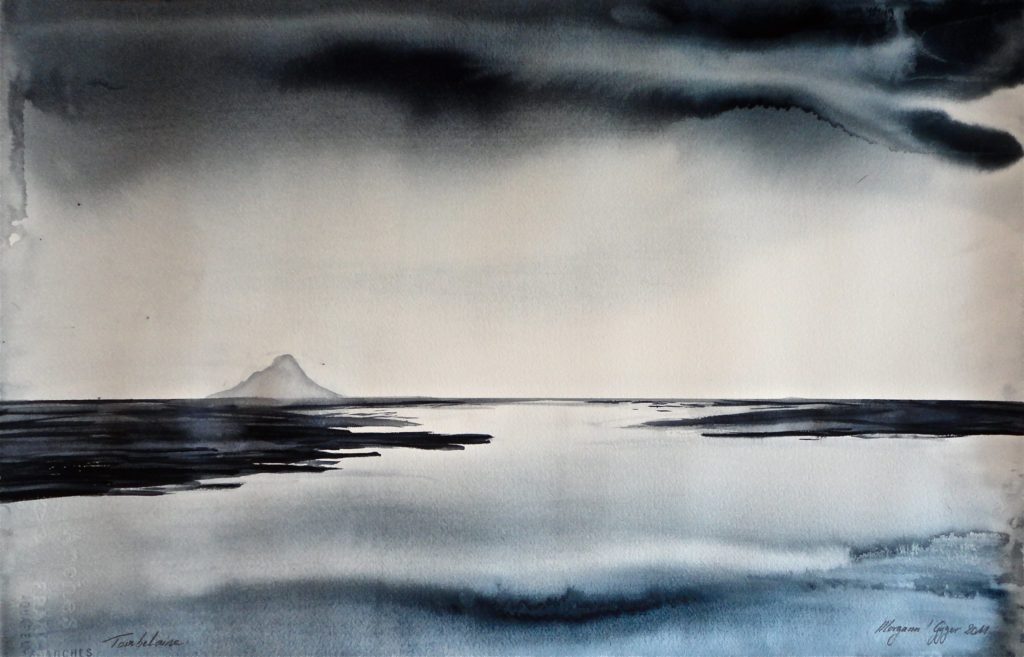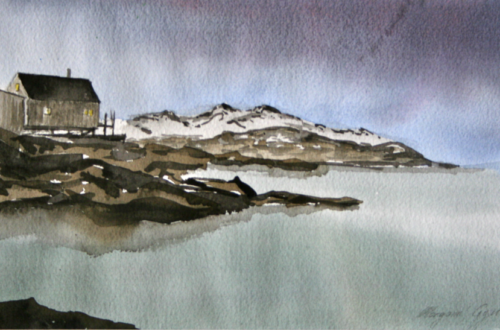
TOMBELAINE, here sleeps the serpent
A watercolor I painted some years ago and that I forgot somewhere in a box. it's a monochrome using only Payne’s Grey pigment. Something I should frame properly. It presents a view from Tombelaine: where sleeps the serpent. It is a nice occasion to speak about this mythical and mystical place.
|ENGLIS|
Tombelaine is a small tidal island off the coast of Normandy. It lies a few kilometers north of the Mont Saint-Michel. (that you can seeing the background of the watercolor).
At low tide the island can be reached on foot. This rocky island lies just to the south of the course of the Sélune river, which according to its snaking fancy, places the mount either in Normandy or in Brittany. According to mythology the name means « the tomb of Elaine « , from a princess named Elaine, daughter of King Hoël said to have been buried on the rocky little mount. The name could also come from Tumuls Belenis, the « tumulus of Belenos », a celtic god, or from Celtic words meaning « the little Mount ».
The legendary tale states that a cave then opened in the side of the rock. This circular temple supported by rough monoliths was the Neimheidh or sanctuary of the ancestors, guarded by nine prophets women called « Sènes » whose sailors came to consult the oracles. We also know a dolmen was once on the site, which one can imagine that the Druids had made a portal to the subtle world.
|FRANÇAIS|
Tombelaine est une petite île, un roché planté au large des côtes Normandes. Elle se situe à quelques kilomètres au nord du Mont Saint-Michel. (que l’on peut observer en fond d’aquarelle).
A marrée basse, l’île peut être atteinte à pieds. Cet îlot rocheux se trouve juste au sud du cours de la rivière Sélune, qui selon sa fantaisie à serpenter déplace sa frontière liquide et fait voyager le mont tantôt en Normandie, tantôt en Bretagne.
Selon une source mythologique, son nom signifie « la tombe d’Elaine », d’une princesse nommée Elaine fille du roi Hoël, qui aurait été enterrée sur l’îlot rocheux.
Le nom pourrait aussi venir de Tumuls Belenis, le « tumulus de Bélénos », un dieux celte; ou alors du mot gaélique signifiant « Le petit mont ».
La légende raconte qu’une caverne se serait ouverte sur le flan du rocher. Ce temple circulaire, supporté par de grands piliers était connu sous le nom de Neimheidh; autrement dit: le sanctuaire des ancêtres. Il était gardé par neuf prophétesse appelées « Sènes » dont les marins venaient consulter les oracles.
Nous savons également qu’un dolmen était présent sur le site et l’on peut facilement imaginer que des druides l’utilisaient comme un portail vers l’autre monde.





